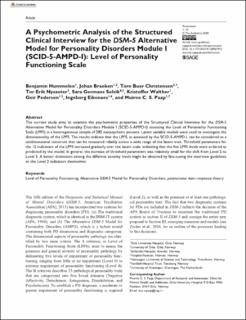| dc.contributor.author | Hummelen, Benjamin | |
| dc.contributor.author | Braeken, Johan | |
| dc.contributor.author | Christensen, Tore Buer | |
| dc.contributor.author | Nysæter, Tor Erik | |
| dc.contributor.author | Germans Selvik, Sara | |
| dc.contributor.author | Walther, Kristoffer Lygren | |
| dc.contributor.author | Pedersen, Geir Feigum | |
| dc.contributor.author | Eikenæs, Ingeborg Helene Ulltveit-Moe | |
| dc.contributor.author | Paap, Muirne C. S. | |
| dc.date.accessioned | 2021-02-02T12:22:26Z | |
| dc.date.available | 2021-02-02T12:22:26Z | |
| dc.date.created | 2020-11-16T08:53:42Z | |
| dc.date.issued | 2020 | |
| dc.identifier.citation | Assessment (Odessa, Fla.). 2020, 1-14. | en_US |
| dc.identifier.issn | 1073-1911 | |
| dc.identifier.uri | https://hdl.handle.net/11250/2725805 | |
| dc.description.abstract | The current study aims to examine the psychometric properties of the Structured Clinical Interview for the DSM-5 Alternative Model for Personality Disorders Module I (SCID-5-AMPD-I) assessing the Level of Personality Functioning Scale (LPFS) in a heterogeneous sample of 282 nonpsychotic patients. Latent variable models were used to investigate the dimensionality of the LPFS. The results indicate that the LPFS, as assessed by the SCID-5-AMPD-I, can be considered as a unidimensional construct that can be measured reliably across a wide range of the latent trait. Threshold parameters for the 12 indicators of the LPFS increased gradually over the latent scale, indicating that the five LPFS levels were ordered as predicted by the model. In general, the increase of threshold parameters was relatively small for the shift from Level 2 to Level 3. A better distinction among the different severity levels might be obtained by fine-tuning the interview guidelines or the Level 2 indicators themselves | en_US |
| dc.language.iso | eng | en_US |
| dc.publisher | SAGE | en_US |
| dc.rights | Navngivelse-Ikkekommersiell 4.0 Internasjonal | * |
| dc.rights.uri | http://creativecommons.org/licenses/by-nc/4.0/deed.no | * |
| dc.title | A psychometric analysis of the structured clinical interview for the DSM-5 alternative model for personality disorders module I (SCID-5-AMPD-I): Level of personality functioning scale | en_US |
| dc.type | Peer reviewed | en_US |
| dc.type | Journal article | en_US |
| dc.description.version | publishedVersion | en_US |
| dc.source.pagenumber | 1-14 | en_US |
| dc.source.journal | Assessment (Odessa, Fla.) | en_US |
| dc.identifier.doi | 10.1177/1073191120967972 | |
| dc.identifier.cristin | 1848166 | |
| dc.description.localcode | https://creativecommons.org/licenses/by-nc/4.0/This article is distributed under the terms of the Creative Commons Attribution-NonCommercial 4.0 License (https://creativecommons.org/licenses/by-nc/4.0/) which permits non-commercial use, reproduction and distribution of the work without further permission provided the original work is attributed as specified on the SAGE and Open Access page (https://us.sagepub.com/en-us/nam/open-access-at-sage). | en_US |
| cristin.ispublished | true | |
| cristin.fulltext | original | |
| cristin.qualitycode | 1 | |

